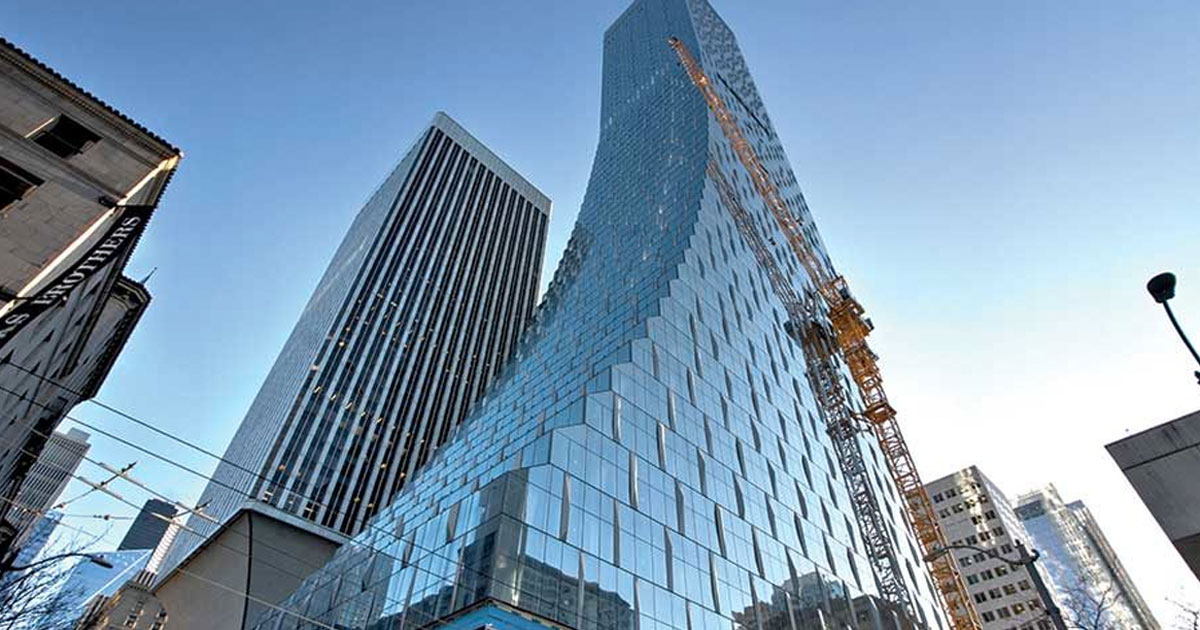Since late 2017, the 200 structural engineers at Magnusson Klemencic Associates—headquartered in Seattle’s 40-story Rainier Tower—had front row seats for a construction reality show on skyscraper history in the making. Looking out their 32nd-floor office windows, they witnessed the speedy rise of one of MKA’s cutting-edge projects—the 850-ft-tall Rainier Square Tower. RST’s composite steel frame, thanks to its novel Lego-like plate-steel sandwich core, sprang up in only 10 months—twice as fast as a steel frame trailing a concrete core.
In the office, “we had 200 pairs of eyes scrutinizing the work,” says Brian G. Morgen, MKA’s project manager for RST. “Every time there was a big bang, six people would stand up and look out the window.”
MKA engineers were not the only ones interested in RST. Developers, architects, contractors, fabricators, erectors, researchers and other engineers flew to Seattle to see the action. “We led one or two site tours a week for a year,” says Morgen.
One visitor was Michel Bruneau, director of the Structural Engineering and Earthquake Simulation Laboratory at the University at Buffalo and one of three peer reviewers required for RST’s performance-based seismic design. “Having been involved in research on [composite sandwich panels] for over a decade, seeing Rainier Square Tower rise was like watching history being made,” Bruneau says.
Last April, excitement at MKA intensified as the 58-story RST neared eye level, even though it blocked the view north of the iconic Space Needle. “We covered up Ron’s office windows with a thank you note to the erection crew for the hard work,” says Morgen. The sign said “Your crew rocks—from MKA.”
“Ron” is MKA’s chairman and CEO Ron Klemencic—ENR’s 2018 Award of Excellence winner—who also is the mastermind of “speed core,” the American Institute of Steel Construction’s nickname for the high-rise system. AISC is a co-sponsor of performance testing on the modules (see p. 28).
Instead of a concrete core to resist lateral loads, RST has a system of dual cross-tied plate-steel modules. In the field, modules are stacked like Legos, welded and then filled with plain concrete to create a sandwich.
Though the 1.1-million-sq-ft tower, designed by architect NBBJ, is not set to open until early September, for MKA engineers—and the rest of RST’s building team—the riveting part of the show ended Aug. 9, when The Erection Co. topped out the steel structure.
It had taken only 10 months. A traditional concrete core would have been at about level 30, with steel trailing at about level 22, according to MKA.
“The erection went surprisingly spectacularly well,” says MKA’s Klemencic, who all but staked his reputation on RST. His aim with speed core is to usher in an era of swifter, safer and easier high-rise construction (ENR 12/25/17-1/1/18 p. 18).
TEC erected the frame two months faster than Adam Jones, its founder and CEO, had predicted several years ago, when he promised to finish the structure 40% faster than a steel frame with a concrete core.
Jones is an ENR Newsmaker for the speed record (ENR 1/20-27 p. 46). But the veteran erector claims TEC could have finished the frame in 71⁄2 to eight months. With a second tower crane, a better supply of modules and no restrictions on street use, “we could have really rocked and rolled,” Jones says.
Shannon Testa, director of commercial markets for RST’s general contractor, Lease Crutcher Lewis (Lewis), says RST “went very smoothly, and the pieces fit together very well.” There were some challenges but nothing insurmountable, she adds. But she cautions that “there’s a long learning curve with this core. It takes a ramp-up period to understand the nuances.”
Still, Testa says speed core is safer for high-rise construction, compared to concrete. “I think that overall, the industry will move toward this,” says Testa, who reports no deaths or significant injuries on the job.
Cindy Edens, executive vice president of development for Wright Runstad & Co., RST’s developer, calls speed core, “my hero core.” She credits the success of the enterprise to the players, who have been collaborating for decades on novel projects, and to WR’s design-build approach to the core. “We stepped into the unknown and figured it out,” says Edens. “It’s always good to have chutzpah and a can-do attitude,” she adds.
That said, RST “has not been an easy project,” says Edens, who declines—with the RST team—to comment on cost, claims or extras.
RST’s opening was originally scheduled for next month. The tardiness is primarily, but not entirely, due to force majeure delays, including a crane operators’ strike in August 2018 and unanticipated restrictions on street use early last year, from the demolition of the nearby Alaskan Way Viaduct to the opening of its replacement—the State Route 99 tunnel. A rare Seattle snowstorm in February 2019 and more than a dozen high-wind days that prevented hoists from running to upper floors also contributed, says Andy Bench, WR’s project manager.
Edens says the schedule drag had nothing to do with speed core, which allowed work-arounds, such as earlier truck deliveries at 4 a.m.
Early arrival and long waiting times would not have worked for concrete mixers. “I thank my lucky stars we were not a concrete core,” Edens says.
The architecture of the carved-back building, dubbed the “kinky boot,” avoids blocking the iconic Rainier Tower, perched next door on its 12-story golf-tee-like pedestal. To shape the RST boot, columns on the east face slope over as few as two floors and as many as 16. There is no typical floor until floor 40.
For stability, on each side of the core at level 38, three lines of 40-ft-deep steel outrigger trusses, with buckling-restrained braces, span to composite outrigger box columns. BRBs will absorb quake energy. An outrigger belt truss provides redundant load paths.


